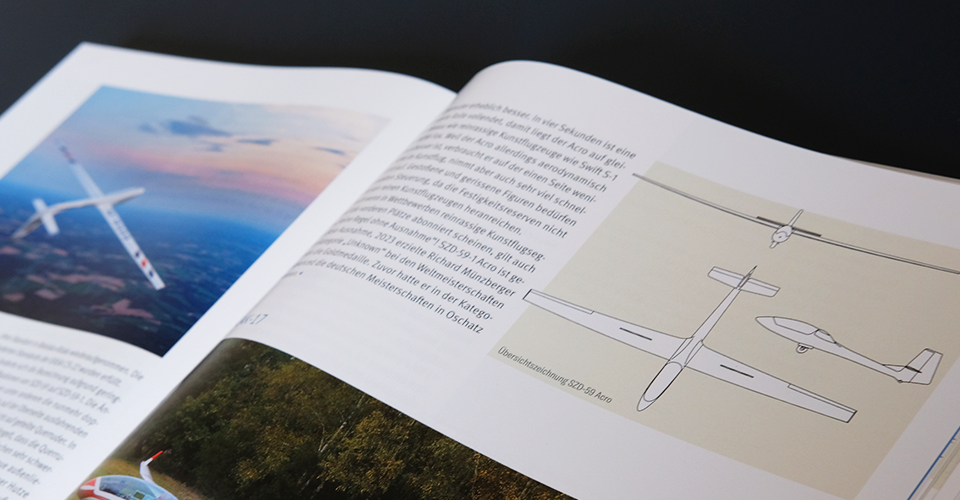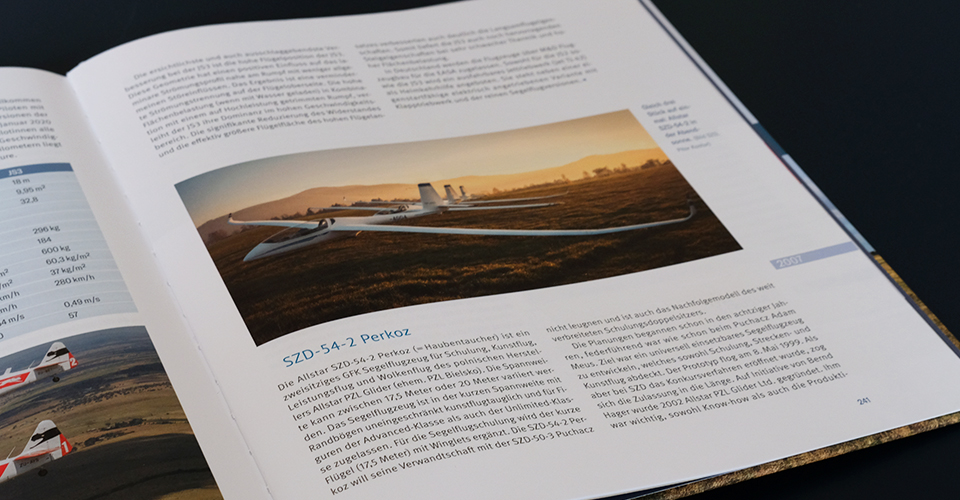The Most Famous Gliders in the World
A major book on international sailplane types is now featuring our modern two-seater SZD-54-2 PERKOZ and our single-seater SZD-59-1 ACRO for the first time.
"The Most Famous Gliders in the World" by Georg Brütting was initially published in Germany in 1970. In the fall of 2023, Alexander Willberg edited this classic for the “Motorbuch Verlag”. The selection includes 160 sailplanes from 1000 types built worldwide since the 1920s.
 The photograph by Tobias Barth shows the Acro in the supreme discipline of aerobatics.
The photograph by Tobias Barth shows the Acro in the supreme discipline of aerobatics.
SZD-59-1 ACRO
"The SZD-59 Acro is the only fully aerobatic single-seater that is still in production."
Alexander Willberg mentions this important fact at the end of his type description. The author provides a brief description of the flight characteristics of the aerobatic sailplane:
"The flight characteristics of the SZD-59-1 in the 15-meter wingspan configuration are similar to those of the Jantar Standard 3, but the roll rate around the longitudinal axis is considerably better due to the significantly larger ailerons. The Acro is capable of completing a controlled roll in four seconds [13.20 meter wingspan], which puts it in line with pure-bred aerobatic aircraft such as the Swift S-1 or MDM-Fox. However the Acro has much better aerodynamic efficiency, it uses less height in aerobatics, but also picks up speed much faster. Snap (flick) manoeuvers require precise control, as the strength reserves do not come close to those of pure aerobatic aircraft."
In 2023, another competition success was achieved at the WAGAC (World Advanced Glider Aerobatic Championships) in Toruń:
"Even though purebred aerobatic sailplanes seem to be subscribed to the top places in competitions, the there is: "No rule without exception"! SZD-59-1 Acro is this exception: Richard Münzberger won the gold medal in the "Unknown" task category at the World Championships in Poland in 2023. He won the German Championships in Oschatz before in the Advanced category."
 Drawing of SZD-59 in the book "The Most Famous Gliders in the World".
Drawing of SZD-59 in the book "The Most Famous Gliders in the World".
The design history of the glider shows how the aerobatic potential was identified and later supplemented to include cross-country flying:
"In the years 1990-91, the ACRO was developed at SZD under the guidance of Jan Knapik as a modification of the SZD-48- Jantar Standard 3. [...] Instead of the T-tail, the Acro was equipped with a conventional tail plane, with a larger rudder. The horizontal stabilizer corresponded to the SZD-42-2.The wing tips were removable, resulting in a wingspan of 13.2 metres for the aerobatic version. In this configuration, the ACRO was certified for +7/-5g and therefor for all aerobatic manoeuvres. During the 1991 World Glider Aerobatics Championships in Zielona Góra, this prototype was briefly demonstrated. 12 units had been delivered by mid-1996. The Production initially ended in 1996 with the bankruptcy of SZD. [...] In 2004, the sailpane production recommenced at the same location in Bielsko-Biala. The required EASA CS-22 standards were met.
The designation was changed from SZD-59 to SZD-59-1 in 2016 due to minor modifications.
The changes include the double-deck airbrakes, which only extend on the upper side, and the elimination of split ailerons. It was criticised in the initial version that the ailerons were very stiff, especially at high load multiples. New external aileron hinges were hidden under small fairings on the SZD-59-1. Furthermore, wingtips and winglets with wingspans of 16.5-metres were developed in the same year. In 2017, the SZD-59/SZD-59-1 received EASA certification for the 13,2-metre and 15-metre variants. The 16.5-metre version is still in the approval process."
 Photographer Pitor Kostur captured a unique moment of three SZD-54-2 gliders at the EPBA airfield next to the Allstar PZL Glider production facilities.
Photographer Pitor Kostur captured a unique moment of three SZD-54-2 gliders at the EPBA airfield next to the Allstar PZL Glider production facilities.
SZD-54-2 PERKOZ
"The Allstar SZD-54-2 Perkoz is a club-worthy aircraft, it covers the entire spectrum of gliding."
Alexander Willberg sums up the flight characteristics of the SZD-54-2 highlighting qualities that are partcularily important for club and training operations:
"The forgiving flight characteristics are maintained throughout the entire speed range. The hand forces are not high even when aero towing and the roll rate is good for a two-seater (yet with a wingspan of 20 meters). Flown as a single-seater, the minimum speed is 62 km/h. The aircraft can be controlled well in a stall. The Perkoz is very good for practicing spins with textbook-like entry and recovery. [...] The sailplane can perform snap (flick) manoeuvres in the acrobatic version."
 Drawing of SZD-54-2 and table with technical data.
Drawing of SZD-54-2 and table with technical data.
The Perkoz was designed as a glider for training, cross-country flying and aerobatics from the beginning. In 2007, the wingspan of 20 metres with winglets was certified.
"The SZD-54-2 Perkoz will not deny its relationship to the SZD-50-3 Puchacz. It is the successor to the widely used training two-seater. During the 1980s, Adam Meus led the design, as he had done for the Puchacz before. An all-purpose sailplane that could be used for training, cross-country flying and aerobatics was the goal. The prototype flew on 8 May 1999, however, due to the commencement of bankruptcy proceedings at SZD, the certification was postponed [...] Poland was set to become a member of the EU in 2004. Therefore, the EASA requirements were implemented, allowing development work to proceed. The result was a completely new glider. The Perkoz was the only two-seater with a proven crashworthiness of 16g. The first flight took place on 2 April 2007."
The SZD-54-2 incorporates established SZD designs such as the laminar N-8 profile from the Jantar Standard and the one-piece canopy from the Puchacz:
"The sailplane is entirely made of glass fibre reinforced plastic (GRP) with the exception of a few parts. The wings are in two parts and the laminar profile N-88 (sic) [NN-8] from the Jantar standard was applied. In contrast to the swept-forward wings of the Puchacz, the Perkoz wings are swept back by 0.7 degrees. It has a large braked main wheel with spring suspension and a nose wheel and a tail caster. [...] The large one-piece canopy opens to the right. [...] The front and rear instrument panels are fixed. Even tall pilots will find plenty of room."
Quotations from the book: The Most Famous Gliders in the World (Original German title: Die berühmtesten Segelflugzeuge der Welt), by Georg Brütting and Alexander Willberg, published by Motorbuchverlag, Stuttgart, 2023
– Original German quotations have been translated by the author of this article –
SZD-59-1 Quotations: Page 219-221, SZD-54-2 Quotations: Page 241-242